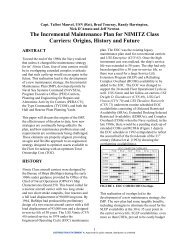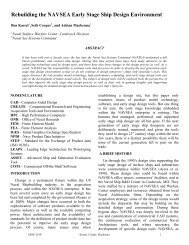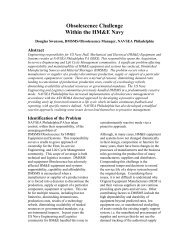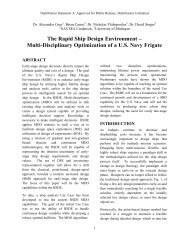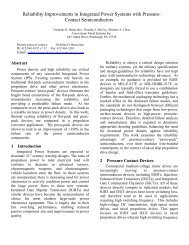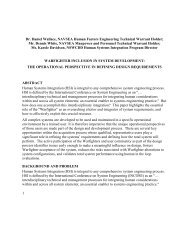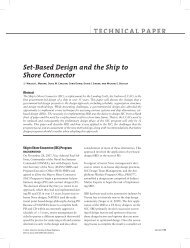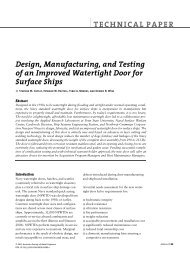The Wreck of DKM Bismarck − A Marine Forensics Analysis 1 The ...
The Wreck of DKM Bismarck − A Marine Forensics Analysis 1 The ...
The Wreck of DKM Bismarck − A Marine Forensics Analysis 1 The ...
Create successful ePaper yourself
Turn your PDF publications into a flip-book with our unique Google optimized e-Paper software.
<strong>The</strong> <strong>Wreck</strong> <strong>of</strong> <strong>DKM</strong> <strong>Bismarck</strong> <strong>−</strong> A <strong>Marine</strong> <strong>Forensics</strong> <strong>Analysis</strong><br />
can be explained in this manner, including the explosion damage starboard in way <strong>of</strong> Turret<br />
Dora. What is seen there is an outburst propagation which ended at a pre-existing torpedo hole.<br />
<strong>The</strong>re may be other, similar instances <strong>of</strong> this, but the evidence is masked by sediment.<br />
<strong>Bismarck</strong> had a slight list to port before the Swordfish aircraft made their torpedo attacks<br />
during the evening <strong>of</strong> 26 May. A review <strong>of</strong> the British airmen’s report <strong>of</strong> the attack is<br />
inconclusive as to the number <strong>of</strong> torpedo hits or where they may have struck the battleship. As<br />
has been mentioned earlier, German survivor testimony is rather conclusive that there were two<br />
torpedo hits sustained amidships, one on either side 15 .<br />
One <strong>of</strong> the last attacking planes reported <strong>Bismarck</strong> was in a port turn. Several survivors<br />
(LCDR Baron von Müllenheim-Rechberg, and Apprentice Seamen Bruno Rzonca and Georg<br />
Herzog) observed two low-flying aircraft making their approach from starboard aft. With the<br />
ship turning to port, the two aircraft made a turn toward <strong>Bismarck</strong> and dropped their torpedoes<br />
very close to the stern 16 . <strong>The</strong>y then over-flew <strong>Bismarck</strong> in their successful effort to escape.<br />
Herzog noted that the 105-mm guns couldn’t depress their barrels low enough to engage the<br />
aircraft as they approached 17 .<br />
During the last torpedo attack that came from astern, two torpedoes quickly approached<br />
<strong>Bismarck</strong>. One missed. <strong>The</strong> other torpedo continued on its fateful path toward the stern. <strong>The</strong>re<br />
are three plausible scenarios regarding the location <strong>of</strong> its detonation:<br />
○ It exploded against the trailing edge <strong>of</strong> the starboard rudder.<br />
○ It exploded to the starboard side <strong>of</strong> the centerline between the two rudders.<br />
○ It exploded in the wake <strong>of</strong> centerline propeller.<br />
We believe that this torpedo passed under the stern and that the wake from the propellers<br />
forced it upwards against the underside <strong>of</strong> <strong>Bismarck</strong>’s stern plating, between the two rudders,<br />
whereupon it exploded with tremendous force. Based on the nature <strong>of</strong> the damage to the hull, we<br />
believe that the torpedo actually exploded to the starboard side <strong>of</strong> the centerline, destroying a<br />
large amount <strong>of</strong> structure, including the structural support for the starboard rudder stock. <strong>The</strong><br />
venting force <strong>of</strong> the torpedo explosion was carried to the port side, causing the port rudder stock<br />
to fail. None <strong>of</strong> the British airmen observed the characteristic water plume <strong>of</strong> an exploding<br />
torpedo in the stern area. This is strong evidence that almost all <strong>of</strong> the force <strong>of</strong> the exploding<br />
torpedo was vented against and into <strong>Bismarck</strong>’s overhanging stern structure.<br />
<strong>The</strong> torpedo hit or exploded under the stern. Its explosion also caused the failure <strong>of</strong> a<br />
large portion <strong>of</strong> the trailing edge <strong>of</strong> the starboard rudder (about 25-50% <strong>of</strong> the total rudder area).<br />
<strong>The</strong> starboard rudder stock and the rudder itself were pushed forward and towards the centerline<br />
15<br />
This information was provided by Baron von Müllenheim-Rechberg during a discussion aboard the<br />
heavy cruiser Dorsetshire after his recovery, as related to authors William Garzke and Robert Dulin<br />
during an interview in Annapolis, Maryland during September 1980. <strong>The</strong> Baron, an artillery specialist,<br />
was the fourth gunnery <strong>of</strong>ficer on <strong>Bismarck</strong>, with a rank <strong>of</strong> LT. Seaman Josef Statz, who was assigned to<br />
Damage Control Central, provided Mr. Garzke a detailed flooding diagram <strong>of</strong> the ship, further confirming<br />
this information.<br />
16<br />
Baron von Müllenheim-Rechberg in his book, Battleship <strong>Bismarck</strong>, A Survivor’s Story, commented<br />
that the torpedo was dropped from only 20 meters astern. That estimate cannot be correct, for that short a<br />
distance would not allow the torpedo to arm. Perhaps the distance was 200 meters.<br />
17<br />
<strong>The</strong> extreme motions <strong>of</strong> the ship in the sea way, coupled with the port list and the trim down by the<br />
bow, may have contributed to this difficulty.<br />
14



